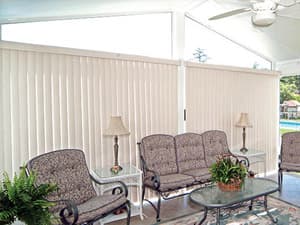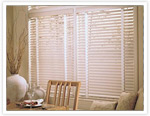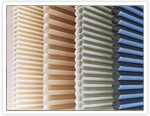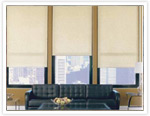You’ve had the perfect custom sunroom added to your home, now you need the perfect window treatment to complement and complete the space. The blinds that are available today can transform the feel of a space through their use of color, texture, materials and design. This article reveals the most popular options for window blinds and offers tips for choosing blinds that will complete the design and style of your new space.
Popular Types of Sunroom Blinds
Vertical Blinds

Vertical blinds have been around for a long time and are still considered one of the most popular choices when it comes to window treatments. These blinds, designed as individual vertical slats, offer excellent light control. Open them wide to let the sunshine in or close them tightly to protect against rays. UV coated verticals create a barrier from the sun for your skin and your furniture, so you don’t have to worry about the fabric on your gorgeous new pillows fading over time.
Mini Blinds

Mini blinds offer great protection against the sun’s harsh rays, as the slats can be opened at various angles to deflect light away from your furniture. They also work well for privacy control, blocking out the sights from a busy street or the stares of the so-close-you-can-touch-them neighbors. Slat sizes usually range from ½” to 2” and look best when paired accordingly to the window size. Use smaller slats for smaller windows and larger slats for those that are bigger.
Cellular Shades

Also known as honeycomb shades due to the cells created in the blind’s design, cellular blinds work well in sunrooms that need added insulation from the elements. These shades consist of two pieces of fabric that are connected at seams, offering almost 100% light blockage. Cellular blinds are known to be the most energy efficient option that can help lower electric bills by keeping extreme air temperatures outside. Another great feature of cellular blinds: You can purchase shades that lower from top to bottom or from bottom to top, which allows for sunlight control and a peekaboo view of the world at the same time.
Roller Shades

Roller shades are exactly as they sound: a shade that rolls up or down the window through the use of a beaded chain or an option motorized control. The shade consists of a solid piece of material and is available in a variety of colors and fabrics, ranging from sheer to light filtering and, at the most extreme end, total blackout.
Which Type Should I Choose?
With so many styles, colors, fabrics, and designs available, how do you choose the best option for your sunroom? Consider the following before making a purchase:
- The direction that your sunroom/windows face. If your sunroom spends most of the day flooded by direct sunlight, you’ll want blinds that can block or deflect these extreme rays. UV coated verticals and cellular shades allow you to shut out the harsh sun while keeping the room at a cooler temperature during the dog days of summer. In fact, cellular shades can offer a reduction in electricity bills. Have windows for ceilings? Cellulars can be custom fit to your specific space and are often used in solariums.
- Focal point of the room. Take a look around your sunroom. Where do your eyes first land? If the focal point is outside, vertical blinds are a great option, as they can be opened wide to allow for an unobstructed view. Choose a bold color to make a statement when the blinds are closed and to accentuate the view when opened. If your focal point rests somewhere within the room, choose a softer hue so the eyes aren’t drawn to the window, or try roller shades. A sheer roller shade offers a peek at the outside world while letting in filtered light.
- Your Decor. Today’s blinds come in an assortment of textures, colors and materials, which means the look and style you want doesn’t have to stop at the walls, it can follow through to the window treatments. Wooden blinds can create a rustic look. I personally love the natural feel of bamboo, which is a popular look for today’s homeowner. (Plus bamboo is a sustainable wood, so it’s good for the environment.) Bold shades and patterns used on blinds create their own style and can pull together an unfinished space.
- Size and shape of your sunroom and windows. Mini blinds and roller shades work well with smaller windows, while vertical blinds are often the best choice for larger panes. Curved windows, as often seen in solariums, look beautiful when decorated with insulating cellular shades. Not only do they keep the heat out, but they create a stunning decorative touch to the room as well. If you’re square-feet limited, consider using tall verticals, which will elongate the room. Keep color in mind too, as cooler shades tend to make a space feel larger.
- Need & desire for privacy. If your sunroom is located in an area that gets a lot of outside traffic, consider purchasing a cellular shade that opens from top to bottom and bottom to top, particularly if you have an unobstructed view of the sky through the upper portion of your window. These shades let in a maximum amount of light but give you the privacy you want when seated in your sunroom. Cellulars work well as noise-blockers too.
Finding the perfect window treatment shouldn’t be a daunting task. Use these tips to find window blinds that will complete the design needs for your new sunroom. If you are ready to find the perfect window treatments for your sunroom, learn more about all of the sunroom shades and blinds sold by Patio Enclosures.
Learn More About Sunroom Accessories
 You May Also Be Interested In:
You May Also Be Interested In: